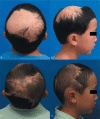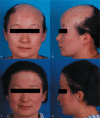Staged reconstructive treatment for extensive irregular cicatricial alopecia after burn
- PMID: 30593127
- PMCID: PMC6314779
- DOI: 10.1097/MD.0000000000013522
Staged reconstructive treatment for extensive irregular cicatricial alopecia after burn
Abstract
For extensive irregular cicatricial alopecia after burn, effective and pleasing restoration of hair-bearing scalp remains challenging. In this article, the authors presented staged reconstructive treatment for extensive irregular cicatricial alopecia with the goal to achieve better and reliable results. A retrospective review of staged reconstructive treatment performed in 16 patients with extensive irregular cicatricial alopecia after burn was conducted. In stage 1, final flaps were designed at 1st. Tissue expanders were placed into the subgaleal plane and serially inflated with normal saline. In stage 2, scarring tissues were excised and the expanded hair-bearing flaps were advanced to the defect. Hair grafts were harvested from excessive hair-bearing scalps excised from the flaps and replanted. For patients with less satisfactory results, stage 3 was performed by hair transplantation. Cicatricial area, follicular unit density, survival rate of hair grafts, and patients' satisfaction were measured before and after each stage. Thirteen patients received 3-stage treatment, and 3 received 2-stage treatment. Significant improvements in aesthetics and patient satisfaction were achieved in all the patients. No flap necrosis, implant exposure or hematoma was observed. Ideal, aesthetic, and reliable results could be obtained using staged reconstructive treatment for patients with extensive irregular cicatricial alopecia after burn.
Conflict of interest statement
The authors have no conflicts of interest to disclose.
Figures



References
-
- Jeong SH, Koo SH, Han SK, et al. An algorithmic approach for reconstruction of burn alopecia. Ann Plast Surg 2010;65:330–7. - PubMed
-
- Desai SC, Sand JP, Sharon JD, et al. Scalp reconstruction: an algorithmic approach and systematic review. JAMA Facial Plast Surg 2015;17:56–66. - PubMed
-
- Khouri RK, Ozbek MR, Hruza GJ, et al. Facial reconstruction with prefabricated induced expanded (PIE) supraclavicular skin flaps. Plast Reconstr Surg 1995;95:1007–15. - PubMed
-
- Leedy JE, Janis JE, Rohrich RJ. Reconstruction of acquired scalp defects: an algorithmic approach. Plast Reconstr Surg 2005;116:54e–72e. - PubMed
-
- Unger W, Unger R, Wesley C. The surgical treatment of cicatricial alopecia. Dermatol Ther 2008;21:295–311. - PubMed
MeSH terms
LinkOut - more resources
Full Text Sources
Medical

